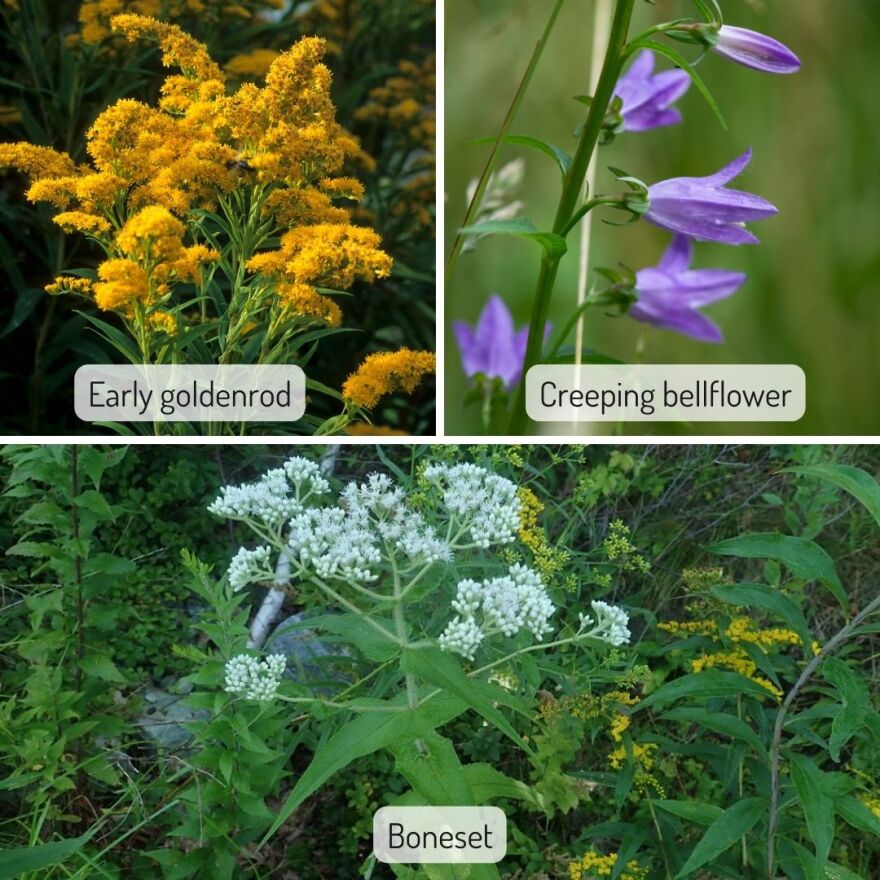John starts off the phenology show with a celebration of summer! He celebrates the fecundity, beauty, and prominence of all the plants and flowers we enjoy at this time of year. Ground-covering plants called spring ephemerals pop up in the spring, show off their beautiful flowers, and finish up quickly before they get shaded out by the overstory. This time of year, though, the countryside is dominated by tall flowers! John has organized them for us:
Large flowers, daisy-sized or bigger:
- Black-eyed Susan: Yellow, with a dark brown center. They are at their peak this week in Grand Rapids!
- Sawtooth Sunflower: Also yellow and about the same size as a black-eyed Susan. John mistook these for a while as woodland sunflowers, but surprise! Most of them were sawtooth sunflowers! It doesn't really matter much; they're wild sunflowers, they can get up to 8 feet tall, their flowers are about 3 inches across with a bright yellow center, and they are lovely.
- Common oxeye: Another big, yellow, ray-petaled flower with a bright yellow center (also known as the false sunflower or smooth oxeye).
- Jerusalem artichoke: Not in bloom yet (but has created flower buds). It will also have a large yellow flower!
- Bindweed: Look for a big, white trumpet-shaped flower that looks like a morning glory. Most are white, but pink varieties exist as well! The bindweed will have an arrowhead-shaped leaf with pointed ends, while morning glories have a heart-shaped leaf with rounded ends (plus, the morning glories aren't found in the Grand Rapids area unless planted).

Medium flowers:
- Common tansy: Look for discs or clusters of asprin-sized yellow flowers, with 15-30 flowers per disc.
- Common mullein: Look for a tall stalk with fuzzy leaves (in their first year, the plant has a rosette of fuzzy leaves with no flower stalk). The stalk can grow 6-8 feet tall, with flowers set around the flowerhead that can be a foot long. The flowers have five yellow petals and are about the size of a quarter. The flowers spiral up the stalk in an offset manner reminiscent of a pine cone's scales; this helps them not get in each other's way!
- Evening primrose: Like the common mullein, this grows from a central rosette and has a tall stalk with yellow flowers. However, the primrose's leaves are not nearly as fuzzy.
- Jewelweed: This amazing plant (one of my favorites!) has an orange flower that looks like a trumpet attached to a fishhook. The flower starts as a pollen-producing male flower. The 'fishhook' contains nectar, which is prized by hummingbirds. When a hummingbird flies up, inserts its beak, and bends its tongue through the 'fishhook' to get the nectar, it changes the shape of the flower and dabs pollen onto the forehead of the hummingbird. As the flower develops, it becomes an ovary-producing female flower. When a hummingbird comes along to drink nectar, the process is reversed, pollen is deposited on the flower, and voila! Pollination has occurred! Jewelweed is also called 'spotted touch-me-not' due to its exploding seed pods. As the seeds develop over the next month, you'll notice small green banana-shaped seed pods on the plant. If you touch a ripe one, it will explode and shower seeds everywhere!

Smaller flowers:
- Early goldenrod: This is a little shorter than the other plants and is at its peak of bloom! The early goldenrod has small but prominent yellow flowers, and you'll often find it in large patches (it spreads through its roots!). It is the only goldenrod in bloom right now in the Grand Rapids area. However, John has found a Canada goldenrod that has produced flower buds, though it hasn't flowered yet. Grey goldenrod, which is similarly developed, is much shorter.
- Boneset: This white flower is just beginning to bloom. It's also called 'throughwart' because its leaves fuse around the stem, making it look like the stem grows through the leaves! You'll find these in wet areas or very close to water.
- Creeping bellwort: This plant has tall purple or blue bell-shaped flowers that form on one side of the stem. The stems can be 2-3 feet tall pretty easily.

Wrapping up their blooming period are wild columbine and the blue flag irises (though we still get to enjoy their prominent seed pods).
Next, John reminds us to get outdoors and find some berries! The blueberries, raspberries, and juneberries are fully ripe, plentiful, and delicious. You can still find red elderberries (bright red berries found on a cone-shaped cluster), but they should not be eaten raw and require special preparation. Definitely cook them, separate the seeds before you eat them, and do your research! While we sate our appetites with blueberries, raspberries, and juneberries, we can look forward to the nannyberries and black chokeberries ripening. Chokeberries can be an acquired taste, and John needs a lot of sugar to find them palatable! I love sour foods, so I'm a fan of them.
John ends with a quick note on butterflies! He was chatting with butterfly expert John Weber from the Nevis area. On the 28th annual Bemidji butterfly count, they found 406 butterflies, and 115 of them were monarchs. However, he has examined over 2000 milkweed plants and found only 16 monarch caterpillars; very concerning! [Monarchs were added to the Red List of Endangered Species last week.]
So, this week, get outside, enjoy those beautiful flowers, find some berries, and bask in the summer abundance!
See something noteworthy? We would love to hear from you! Get in touch with me (smitchell@kaxe.org) or John (jlatimer@kaxe.org), or text 'phenology' to 218-326-1234.
For more phenology content, subscribe to our Season Watch newsletter!






